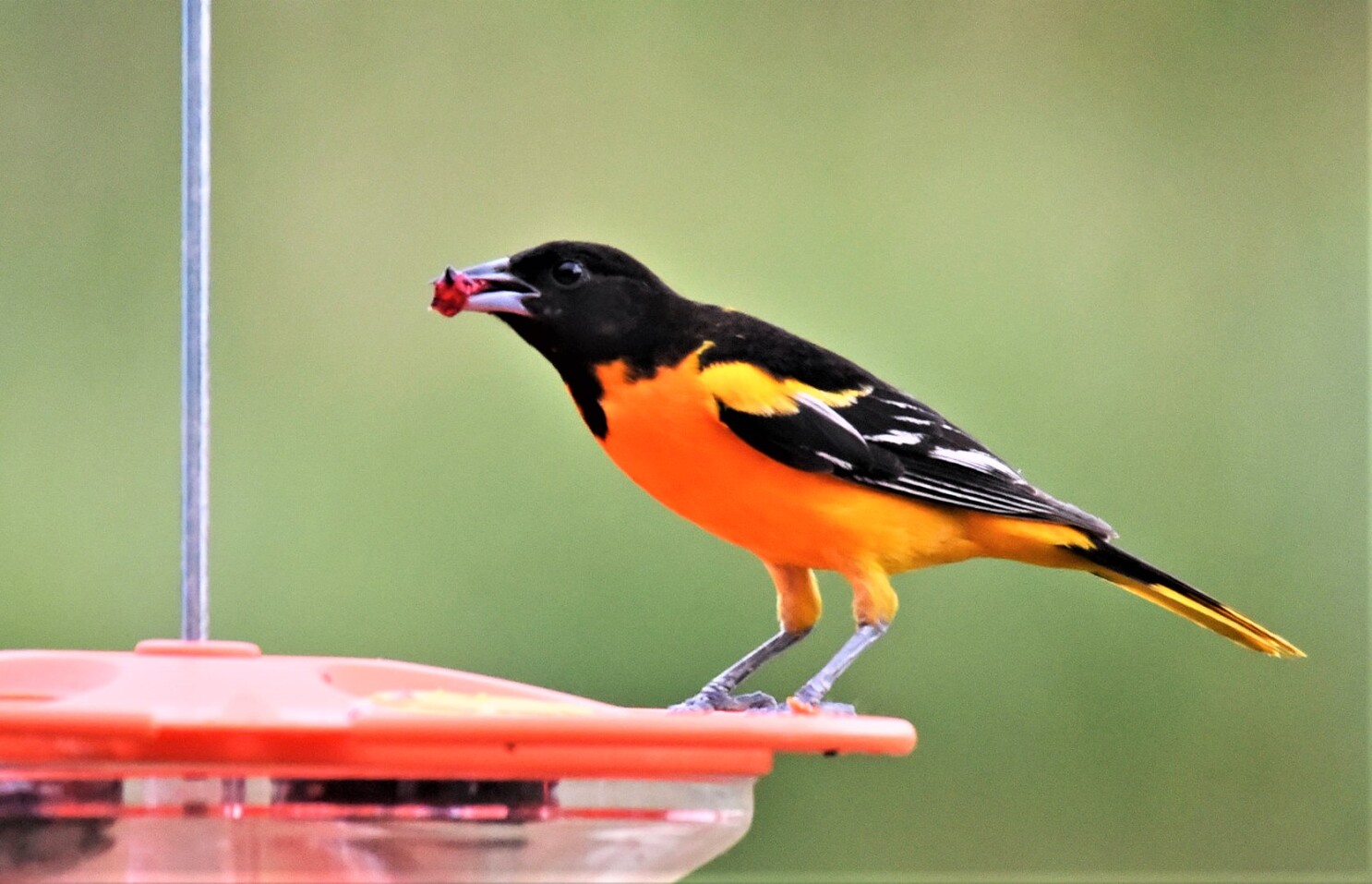In Massachusetts, during the arrival of warblers in spring and summer, yellow birds are quite common, but during winter, the American Goldfinch is the predominant yellow bird in the area.
To assist you in identifying the yellow birds you spot in Massachusetts, this comprehensive guide provides you with pictures, identification details, song recordings, and migration patterns.
The majority of yellow birds found in Massachusetts are warblers, orioles, or tanagers, and sometimes the female birds exhibit distinct differences from the males of their species.
With the information provided in this guide, identifying yellow birds will become much easier. The list of yellow birds is arranged based on their frequency of sightings in Massachusetts during spring and summer (May and June), as reported in ebird checklists.
Yellow birds in Massachusetts throughout the year include the American Goldfinch, Eastern Meadowlark, Summer Tanager, and Yellow-headed Blackbird.
During the summer season, you can spot Common Yellowthroats, Baltimore Orioles, Cedar Waxwings, Yellow Warblers, Pine Warblers, American Redstarts, Black-throated Green Warblers, Scarlet Tanagers, Prairie Warblers, Orchard Orioles, Blue-winged Warblers, Yellow-throated Vireos, White-eyed Vireos, Hooded Warblers, and Prothonotary Warblers in Massachusetts.
In winter, the Evening Grosbeak, Orange-crowned Warbler, Yellow-throated Warbler, and Painted Bunting are the yellow birds typically seen in Massachusetts.
During migration, keep an eye out for Yellow-rumped Warblers, Palm Warblers, Magnolia Warblers, Nashville Warblers, Wilson’s Warblers, Canada Warblers, Cape May Warblers, Dickcissels, and Western Kingbirds.
Read further to successfully identify the yellow birds you have encountered.
A total of 32 Yellow Birds in Massachusetts:
1. American Goldfinch
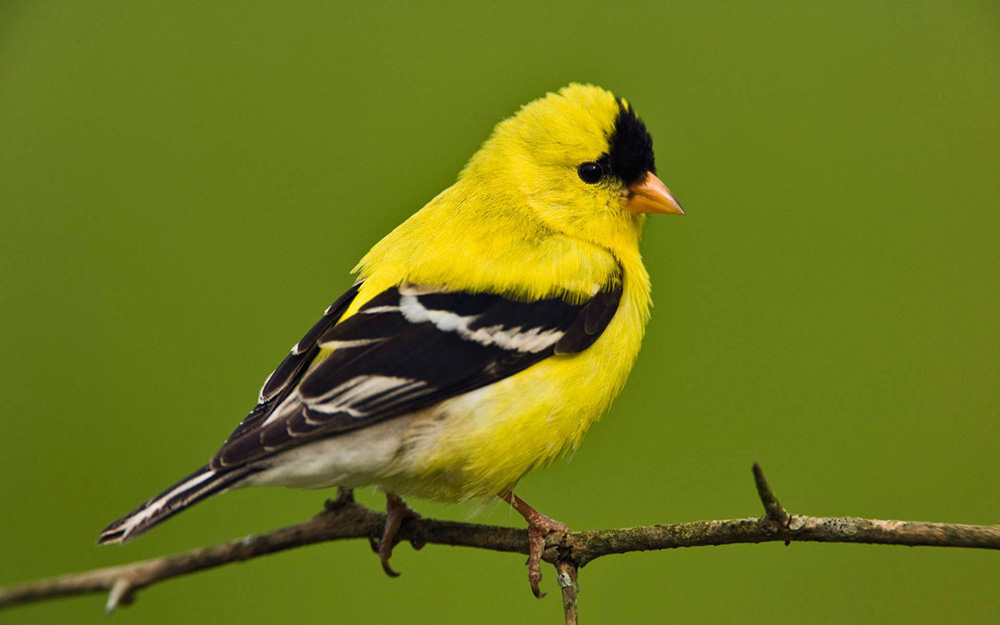
For the purpose of identification, the American Goldfinch displays distinct features. These birds can be seen in Massachusetts throughout the year, but their population increases during the breeding season from April to September. According to birdwatchers’ checklists, they are observed in 49% of summer checklists and 26% of winter checklists.
Renowned for their vibrant yellow and black coloring in spring, the male American Goldfinches are particularly popular. On the other hand, the females appear in duller brown shades, as do the males during winter.
Spinus tristis
Size: 4.3-5.1 in (11-13 cm)
Weight: 0.4-0.7 oz (11-20 g)
Wingspan: 7.5-8.7 in (19-22 cm)
American Goldfinches can be found in various regions of North America and usually remain residents throughout the year. However, those that breed in Canada and the Midwest migrate to southern US states during winter.
These delightful birds can be spotted foraging in weedy fields, overgrown areas, suburbs, parks, and backyards, where they feed on sunflower, thistle, and aster plants.
American Goldfinch Song:
Their nests are typically located in shrubs and constructed from rootlets and plant materials tightly woven together, secured to branches with spiders’ webs. They lay up to seven eggs, which take approximately two weeks to hatch, and the young birds leave the nest after two to two and a half weeks.
You can attract American Goldfinches to your backyard by planting thistles and milkweed. They are frequent visitors to bird feeders and show a preference for sunflower seeds and nyjer seed.
Interesting Fact: Cowbirds fail to successfully raise their young with American Goldfinches due to the finches’ exclusively vegetarian diet, resulting in the cow
bird chicks perishing within a few days.
2. Common Yellowthroat
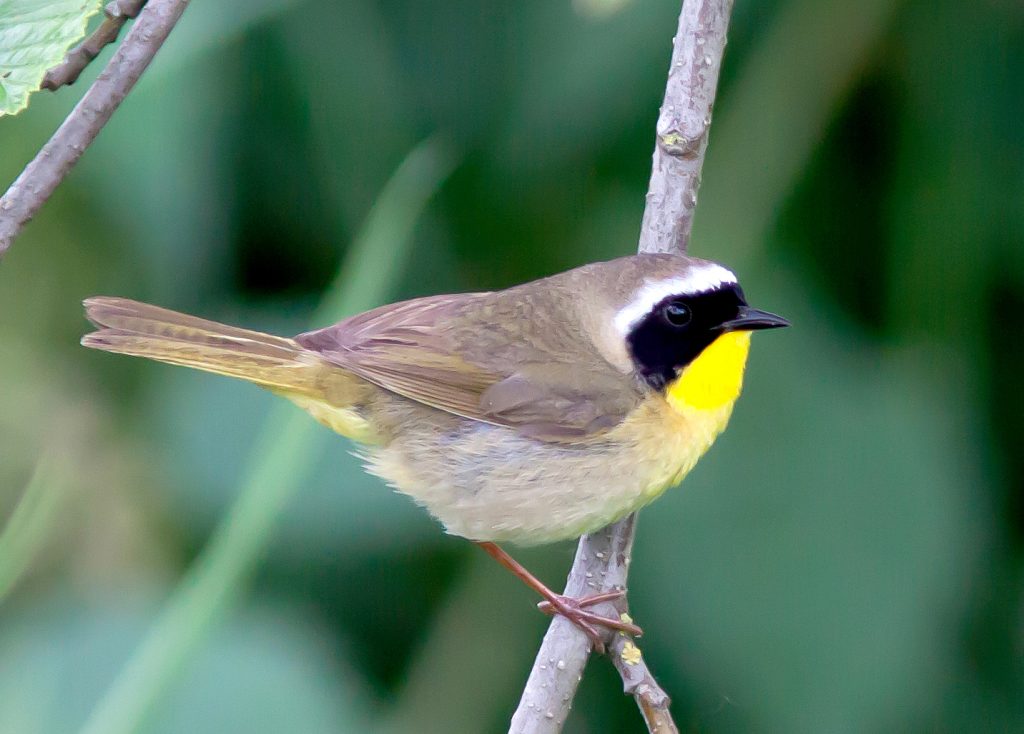
The Common Yellowthroats spend the breeding season in Massachusetts and are predominantly seen from May to November, appearing in 33% of summer checklists.
These small songbirds feature a brownish color on their backs and vibrant yellow undersides, accompanied by long tails. Males display black masks across their faces. The intensity of their yellow coloration may vary geographically, and their undersides can have an olive hue.
Geothlypis trichas
Size: 4.3-5.1 in (11-13 cm)
Weight: 0.3-0.3 oz (9-10 g)
Wingspan: 5.9-7.5 in (15-19 cm)
Common Yellowthroats primarily breed across most of North America, excluding Alaska and northern Canada. Some individuals remain year-round along the Gulf Coast and Pacific Southwest. During winter, they migrate south.
These birds are often found in marshy or wetland areas and brushy fields, residing within dense, tangled vegetation.
Common Yellowthroat Song:
Their nests are built by females near the ground in marshy regions, supported by reeds. Constructed from grass and sedges, the nest is held together by leaves and grass, with a lining of softer materials like hair and feathers. They lay up to six eggs, which take around twelve days to hatch, followed by the young leaving the nest in the same duration.
To attract Common Yellowthroats to larger backyards, create dense vegetation and incorporate native plants that attract insects.
Interesting Fact: Male Common Yellowthroats perceive the black mask of their species as a sign of another male, leading to attacks on fake birds with masks but no response when the bird lacks a mask.
3. Yellow-rumped Warbler
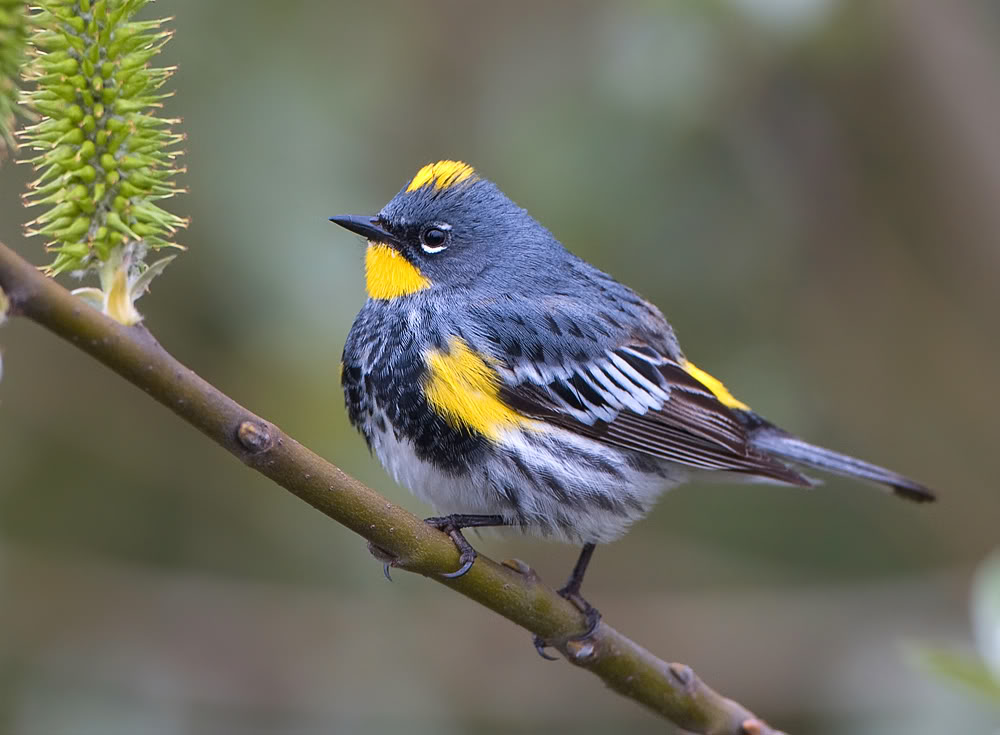
Yellow-rumped Warblers are present in Massachusetts throughout the year, but they are primarily spotted during migration from April to May and September to November. They are reported in up to 39% of checklists during migration.
These warblers exhibit gray plumage with yellow accents on the face, sides, and rump, as well as white patches on their wings. Females may appear slightly brown, while winter birds display a paler brown color with bright yellow rumps and sides that transition back to gray and yellow during spring.
Setophaga coronata
Size: 4.7-5.5 in (12-14 cm)
Weight: 0.4-0.5 oz (12-13 g)
Wingspan: 7.5-9.1 in (19-23 cm)
Yellow-rumped Warblers predominantly breed in Canada, the Rockies, and the Appalachian mountains. During migration, they can be observed in the Midwest before overwintering in southern and southwestern US states, along the Pacific Coast, Mexico, and Central America.
You can find Yellow-rumped Warblers in coniferous forests, particularly during the breeding season. In winter, they frequent open areas with fruiting shrubs. Their diet consists mostly of insects during summer and migration, while fruits such as bayberry and wax myrtle become their primary food sources in winter.
Yellow-rumped Warbler Song:
Their nests are constructed by females in conifer trees using twigs, pine needles, and grass. These nests are lined with soft grass, moss, and hair. Yellow-rumped Warblers lay up to six eggs, which hatch after approximately two weeks. The young birds leave the nest in two to three weeks.
To attract Yellow-rumped Warblers to your backyard, provide sunflower seeds, suet, raisins, and peanut butter.
Interesting Fact: During winter, Yellow-rumped Warblers form flocks numbering in the thousands and display aggression towards other
species that encroach upon their territory.
4. Baltimore Oriole (Female)

Baltimore Orioles spend the breeding season in Massachusetts, but their numbers increase during spring migration in May. They are recorded in 34% of summer checklists and up to 54% of checklists during spring migration.
These birds are a vibrant symbol of spring in the eastern regions of North America. Adult males boast bright orange and black plumage, adorned with white wing bars on their black wings.
Females showcase yellowish undersides and heads, with grayish-brown wings and brownish-yellow backs. They are similar in size to a Robin but possess a more slender physique. Baltimore Orioles belong to the blackbird family.
Icterus galbula
Size: 6.7-7.5 in (17-19 cm)
Weight: 1.1-1.4 oz (30-40 g)
Wingspan: 9.1-11.8 in (23-30 cm)
Baltimore Orioles breed in Eastern and Central States, including central-southern Canadian provinces and areas along the southern US border. During winter, they migrate to Florida, Central America, and the Caribbean, often departing as early as July.
You can spot Baltimore Orioles in open woodlands, riverbanks, forest edges, parks, and backyards. Their diet consists of insects like beetles, crickets, grasshoppers, spiders, and snails. They also consume a wide variety of fruits and can cause damage to crops such as raspberries, mulberries, cherries, bananas, and oranges.
Baltimore Oriole Sounds: The melodious, flute-like sound of Baltimore Orioles is one of the delights of spring. They also emit chattering and sharp alarm calls.
Attract Baltimore Orioles to your backyard by providing halved oranges on a platform feeder or hanging them from trees. Oriole feeders filled with sugar water can also be used. Planting fruit-bearing and nectar-rich plants like raspberries, crab apples, and trumpet vines will further entice them.
Interesting Fact: Baltimore Orioles build incredible bag-like nests, meticulously woven from fibers.
5. Cedar Waxwing

Cedar Waxwings can be seen in Massachusetts throughout the year, but they are more commonly observed during the breeding season from June to November. They are recorded in 18% of summer checklists and 3% of winter checklists in the state.
These elegant and sociable birds possess pale brown plumage on their heads, chests, and crests, which gradually fades to gray on their backs and wings. Their bellies exhibit a pale yellow hue, while the tips of their wings display bright yellow. They also sport a narrow black mask across their eyes and bright red wingtips.
Bombycilla cedrorum
Size: 5.5-6.7 in (14-17 cm)
Weight: 1.1 oz (32 g)
Wingspan: 8.7-11.8 in (22-30 cm)
Cedar Waxwings breed in Canada before migrating to southern US states, Mexico, and Central America for winter. They remain residents all year in northern US states.
These birds can be found in berry bushes, woodlands, grasslands, towns, and along streams. While they primarily feed on fruit, they also consume insects during the summer.
Cedar Waxwing Call:
Their nests are constructed in trees using twigs, grass, hair, and plant material. The nests are lined with pine needles and soft grass. Cedar Waxwings lay up to six eggs, which hatch after around twelve days. The young birds leave the nest approximately sixteen days later.
To attract Cedar Waxwings to your backyard, plant native trees and shrubs that bear small fruits such
as serviceberry, dogwood, juniper, winterberry, and hawthorn. You can also offer fruit on platform feeders.
Interesting Fact: Cedar Waxwings exchange gifts during courtship, passing objects between each other.
6. Yellow Warbler
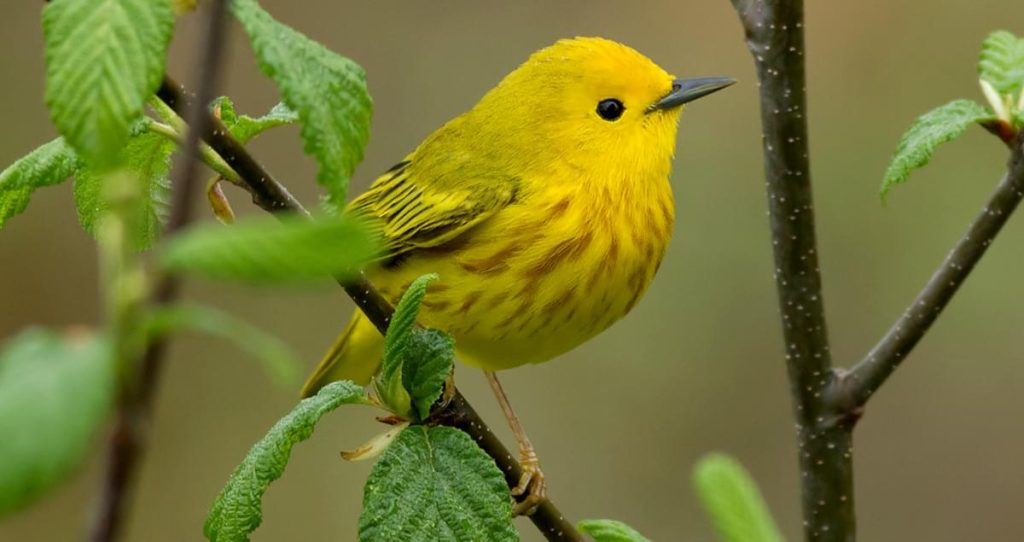
Yellow Warblers can be spotted during the breeding season in Massachusetts and are observed in 32% of summer checklists. They arrive in April and begin their migration in October.
These small, bright yellow birds possess a yellow-green back, with male individuals showcasing chestnut streaks on their breasts. Females and juveniles are not as vibrant as males.
Setophaga petechia
Size: 4.7-5.1 in (12-13 cm)
Weight: 0.3-0.4 oz (9-11 g)
Wingspan: 6.3-7.9 in (16-20 cm)
Yellow Warblers undertake a long-distance migration, breeding in Canada and the US (excluding southeastern states), and wintering in Central and South America. However, they can be observed during migration in southeastern US states.
You can find Yellow Warblers near streams, wetlands, thickets, and field edges, foraging for insects like caterpillars, midges, beetles, bugs, and wasps.
Yellow Warbler Song:
Their nests are typically located in small trees or shrubs and are constructed using bark, grass, and plant material woven together, secured with spiders’ webs. The nests are lined with softer materials such as hair, feathers, and plant down.
Yellow Warblers lay up to seven eggs, which hatch after around twelve days. The young birds leave the nest approximately ten days later.
To attract Yellow Warblers to your backyard, provide suet, oranges, peanut butter, and plants that bear berries. Additionally, plant native flora that attracts insects without the use of pesticides or excessive tidiness. Birdbaths with fountains placed near secluded plantings can offer protection as well.
Interesting Fact: Yellow Warblers respond to the presence of cowbird eggs in their nests by constructing a new nest on top of the old one, repeating this process up to six times.
7. Pine Warbler
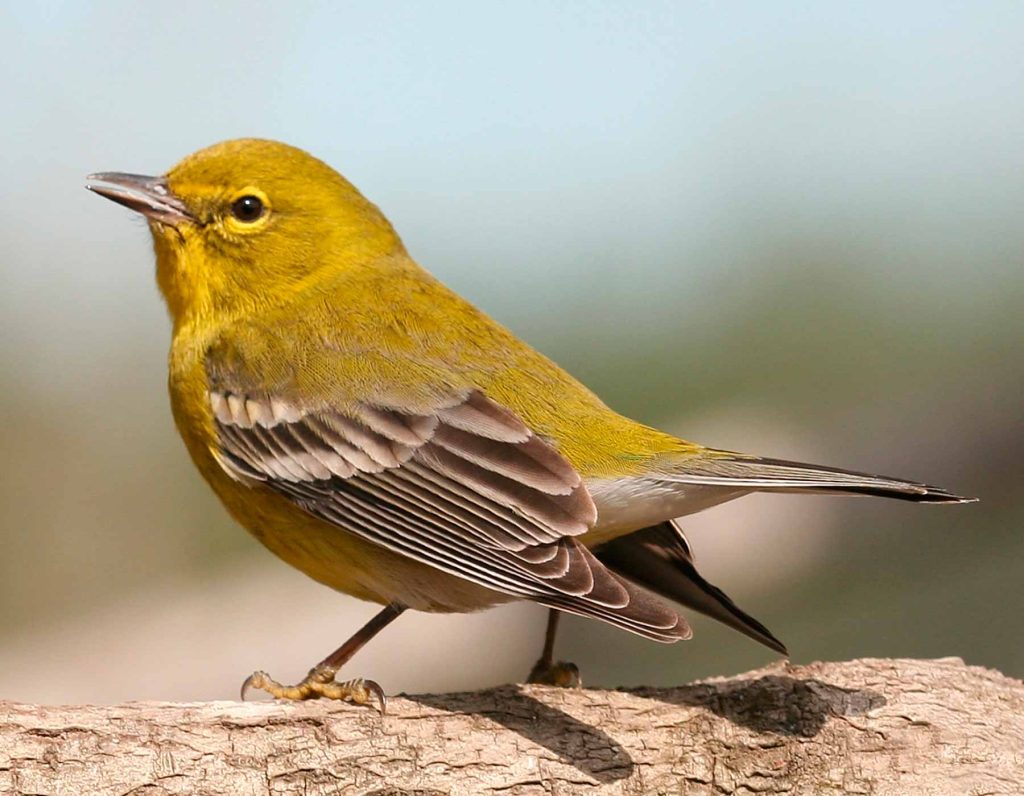
Pine Warblers are recorded in 16% of summer checklists in Massachusetts, and although some individuals can be spotted throughout the year, they are most common from April to July.
These birds are small and plump, with yellow plumage and olive-toned backs. They possess white lower bellies and gray wingbars. Females may appear browner and exhibit more white on their bellies.
Setophaga pinus
Size: 5.1-5.5 in (13-14 cm)
Weight: 0.3-0.5 oz (9-15 g)
Wingspan: 7.5-9.1 in (19-23 cm)
Pine Warblers breed in northeastern US states before migrating to southeastern US states. Some individuals remain year-round in southeastern US states.
You can find Pine Warblers in pine forests, where they tend to stay high up in the trees. They primarily feed on caterpillars, beetles, spiders, and other insects and larvae. During colder weather, they consume fruits and seeds.
Pine Warbler Song:
Their nests are, unsurprisingly, located in pine trees. Constructed from twigs, bark, pine needles, and grass, the nests are held together by spiders’ silk and lined with feathers and animal hair. Pine Warblers lay up to five eggs, which take approximately two weeks to hatch. The young birds leave the nest after another ten days.
To attract Pine Warblers to your yard, use tube feeders and platform feeders filled with millet, cracked corn, sun
flower seeds, peanut hearts, and suet. Additionally, plant native fruits and vines such as bayberry, grape, sumac, and Virginia creeper.
Interesting Fact: Pine Warblers primarily consume seeds compared to other warbler species, making them more likely visitors to backyard feeders.
8. American Redstart (Female)
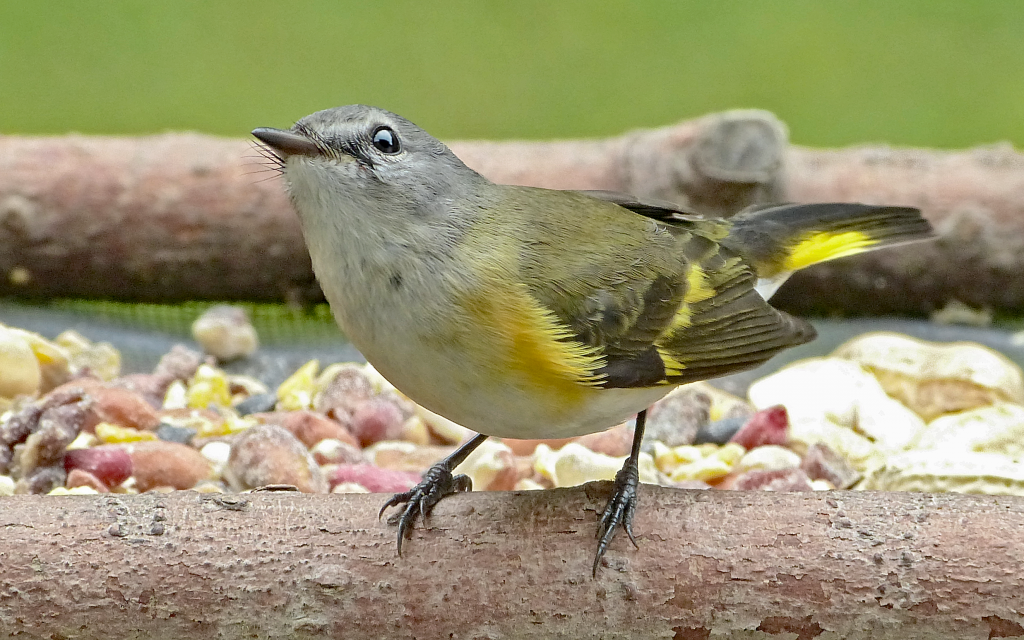
American Redstarts spend the breeding season in Massachusetts and are more commonly observed during spring and fall migration. They are recorded in 15% of summer checklists and up to 34% of checklists during migration.
Male American Redstarts feature predominantly black plumage with striking orange patches and a white belly. Females exhibit an olive-gray coloration instead of black, adorned with numerous yellow patches.
Setophaga ruticilla
Size: 4.3-5.1 in (11-13 cm)
Weight: 0.2-0.3 oz (6-9 g)
Wingspan: 6.3-7.5 in (16-19 cm)
American Redstarts breed in eastern US states, Canada, and northwestern US states. They can also be observed during migration in central and western US states.
You can find American Redstarts in deciduous woodlands, where they forage for insects. They can also be spotted in backyards and thickets, consuming berries such as serviceberry and magnolia.
American Redstart Song: Their song includes a drop in pitch at the end.
Their nests are situated near the tree trunk, often in trees or large shrubs. Constructed using bark, grass, and plant material, the nests are held together with spiders’ webs and lined with animal hair, moss, and feathers. American Redstarts lay up to five eggs, which hatch after just under two weeks, and the young birds leave the nest after a week or two.
To attract American Redstarts to your backyard, provide berry-producing plants such as magnolia and serviceberry.
Interesting Fact: Male American Redstarts can sing over 400 times in an hour and perform a “gloating” flight display after chasing away rivals.
9. Palm Warbler

Palm Warblers can be observed in Massachusetts during their migration from April to May and September to November. They are recorded in up to 17% of checklists during these periods. However, a few individuals also linger during winter.
Palm Warblers feature a rusty red patch on the top of their heads and are primarily brownish-olive in color throughout their bodies. While they breed in Canada, they can be found in eastern US states during migration and year-round along the far south coast and in Florida.
Setophaga palmarum
Size: 4.7-5.5 in (12-14 cm)
Weight: 0.3-0.5 oz (7-13 g)
Wingspan: 7.9-8.3 in (20-21 cm)
Palm Warblers primarily breed in Canada and can be observed during migration in eastern US states. Some individuals spend winter in Florida and along the southeastern coast.
You can spot Palm Warblers during spring and fall migration in weedy fields, forest edges, and scrubby areas. They often forage on the ground alongside other birds such as Sparrows, Juncos, and Yellow-rumped Warblers.
Palm Warbler Song:
Their nests are located in bogs and boreal forests on the ground. Constructed from grass, sedge, and ferns, the nests are woven into a cup shape and lined with soft grass, feathers, and animal hair. Palm Warblers lay around five eggs.
To attract Palm Warblers to your backyard, plant native plants that attract insects and consider bayberry or hawthorn for their berries.
Interesting Fact: Unlike most war
blers, Palm Warblers typically walk on the ground, bobbing their tails as they search for insects.
10. Black-throated Green Warbler
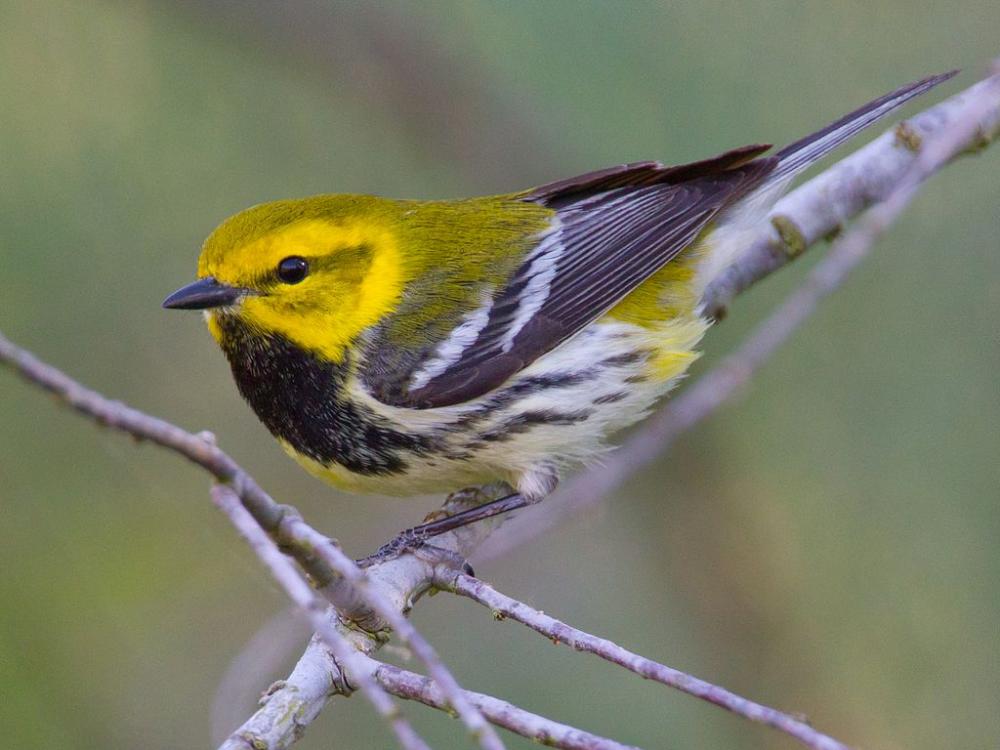
Black-throated Green Warblers are observed in Massachusetts during the breeding season and can be seen from April to December. They are recorded in 9% of summer checklists.
These small yellow songbirds possess a yellow face and head, along with an olive-yellow back. They have black streaking on their sides and wings and exhibit whitish undersides. Male individuals boast large black patches on their throats, whereas females and juveniles feature smaller patches.
Setophaga virens
Size: 4.3-4.7 in (11-12 cm)
Weight: 0.3-0.4 oz (7-11 g)
Wingspan: 6.7-7.9 in (17-20 cm)
Black-throated Green Warblers are mostly observed during their lengthy migration over eastern US states, as they journey to their breeding grounds in northeastern US states and Canada. They spend their winters in Mexico, northern South America, and the Caribbean.
You can find Black-throated Green Warblers high up in forests, where they feed on insects. Their black throat distinguishes them from other small yellow birds.
Black-throated Green Warbler Song:
Their nests are situated in small trees, positioned close to the trunk. Constructed from twigs and bark woven together with spiders’ webs, the nests are lined with animal hair, moss, and feathers. Black-throated Green Warblers lay around four eggs, which hatch after twelve days, and the young birds leave the nest after another ten days.
To attract Black-throated Green Warblers to your backyard, provide mature trees.
Interesting Fact: Male Black-throated Green Warblers can sing more than 400 times in an hour and perform a “gloating” flight after chasing off rivals.
11. Scarlet Tanager

Scarlet Tanagers are a sight to behold during the breeding season in Massachusetts. They are often observed from May to August and appear in approximately 11% of summer checklists.
These striking birds showcase vibrant red plumage, with black wings and tails. Adult males possess a glossy black body with bright red plumage on their heads and bodies. Females and juveniles, on the other hand, exhibit olive-green coloration with a tinge of yellow.
Piranga olivacea
Size: 6.3-7.1 in (16-18 cm)
Weight: 0.8-1 oz (23-28 g)
Wingspan: 9.8-11.4 in (25-29 cm)
Scarlet Tanagers breed in the northeastern and north-central regions of the United States, as well as parts of southeastern Canada. They then migrate to South America for winter.
These birds prefer to inhabit mature deciduous forests, where they forage for insects, spiders, and fruits.
Scarlet Tanager Song:
Their nests are typically located high up in deciduous trees. Constructed from twigs, grass, and leaves, the nests are lined with softer materials such as plant fibers and animal hair. Scarlet Tanagers lay around three to five eggs, which take approximately two weeks to hatch. The young birds leave the nest about ten to twelve days later.
To attract Scarlet Tanagers to your backyard, provide a variety of mature trees and shrubs that offer insects and fruits.
Interesting Fact: The bright red plumage of male Scarlet Tanagers is a result of their diet, as it is derived from consuming pigments found in insects and fruits.
12. Prairie Warbler
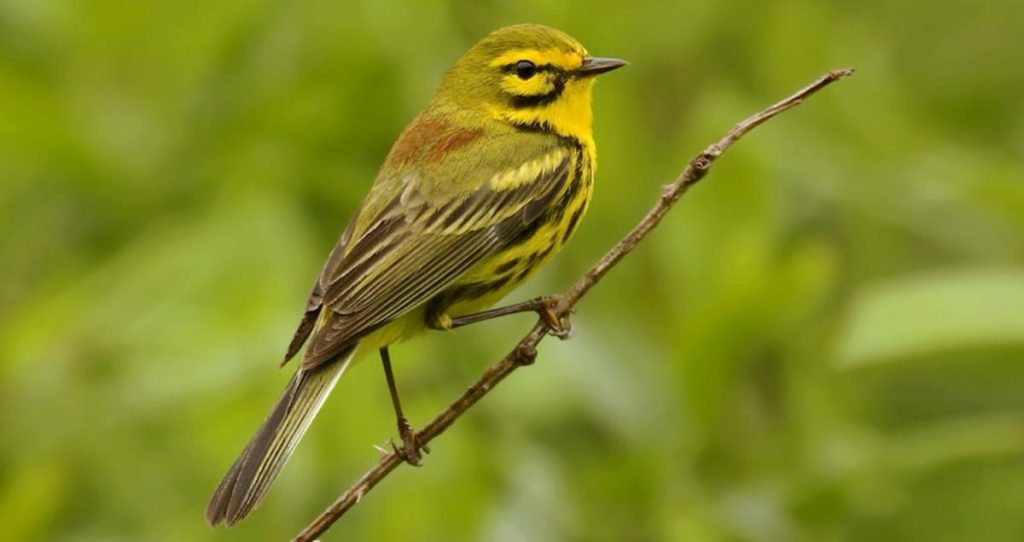
Prairie Warblers grace Massachusetts during the breeding season, typically from May to September. They are recorded in approximately 10% of summer checklists.
These small, lively birds feature bright yellow plumage with black streaks on their sides and backs. Males exhibit distinct black markings on their faces, throats, and breasts, while females possess lighter yellow coloration and less prominent markings.
Setophaga discolor
Size: 4.3-5.1 in (11-13 cm)
Weight: 0.3-0.4 oz (9-12 g)
Wingspan: 6.3-7.1 in (16-18 cm)
Prairie Warblers breed in the eastern and southeastern regions of the United States before migrating to the Caribbean and Central America for winter.
They prefer shrubby areas, such as old fields, brushy habitats, and young forests. Their diet mainly consists of insects, which they capture while foraging in vegetation.
Prairie Warbler Song:
Their nests are located on the ground or in low shrubs, often hidden among vegetation. Constructed from grasses, leaves, bark, and hair, the nests are lined with fine grasses and plant fibers. Prairie Warblers lay around three to five eggs, which hatch after approximately twelve days. The young birds fledge around eight to ten days after hatching.
To attract Prairie Warblers to your backyard, maintain shrubby habitats with plenty of cover and provide a diverse insect population.
Interesting Fact: Prairie Warblers have a unique song that resembles a rising and falling buzzy trill, often described as “zee-zee-zee-zoo-zee.”
13. Orchard Oriole
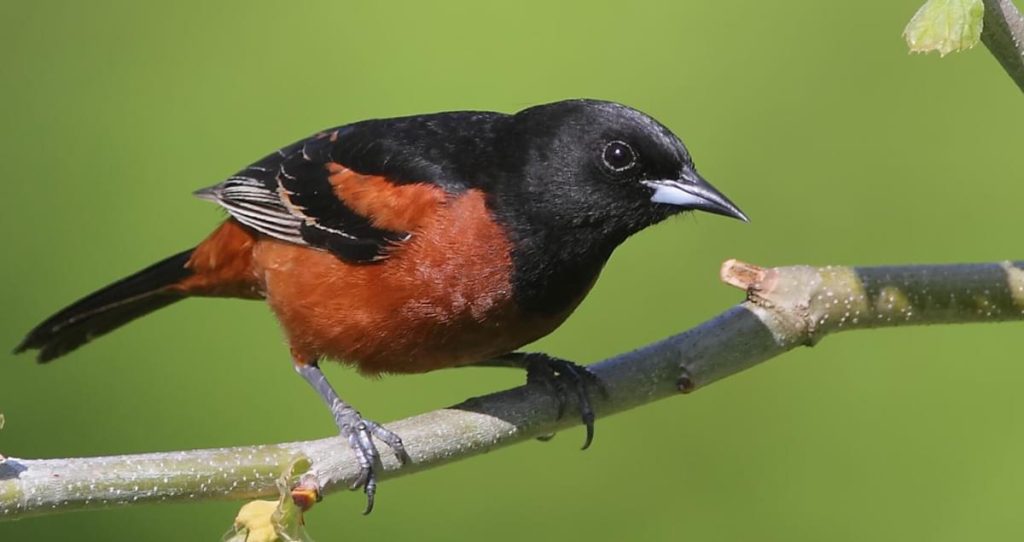
Orchard Orioles visit Massachusetts during the breeding season, typically from May to August. They are observed in about 8% of summer checklists.
Male Orchard Orioles exhibit a striking appearance with dark chestnut plumage on their heads, backs, and tails, while their underparts are a vibrant shade of yellow. Females and immature birds, on
the other hand, possess olive-green coloration with yellowish underparts.
Icterus spurius
Size: 6.3-7.1 in (16-18 cm)
Weight: 0.6-0.8 oz (17-22 g)
Wingspan: 8.7-9.8 in (22-25 cm)
Orchard Orioles breed in the eastern and central regions of the United States before migrating to Mexico and Central America for winter.
They are commonly found in open woodlands, orchards, and the edges of forests. Orchard Orioles primarily feed on insects, spiders, and nectar from flowers.
Orchard Oriole Song:
Their nests are often located in deciduous trees, hanging from slender branches. Constructed from grasses, plant fibers, and other fine materials, the nests are woven together to form a cup-shaped structure. Orchard Orioles lay around three to six eggs, which hatch after approximately two weeks. The young birds leave the nest about two weeks after hatching.
To attract Orchard Orioles to your backyard, provide flowering plants that produce nectar and offer a variety of insects for them to feed on.
Interesting Fact: Orchard Orioles are known to hybridize with Baltimore Orioles, resulting in unique plumage combinations.
14. Blue-winged Warbler
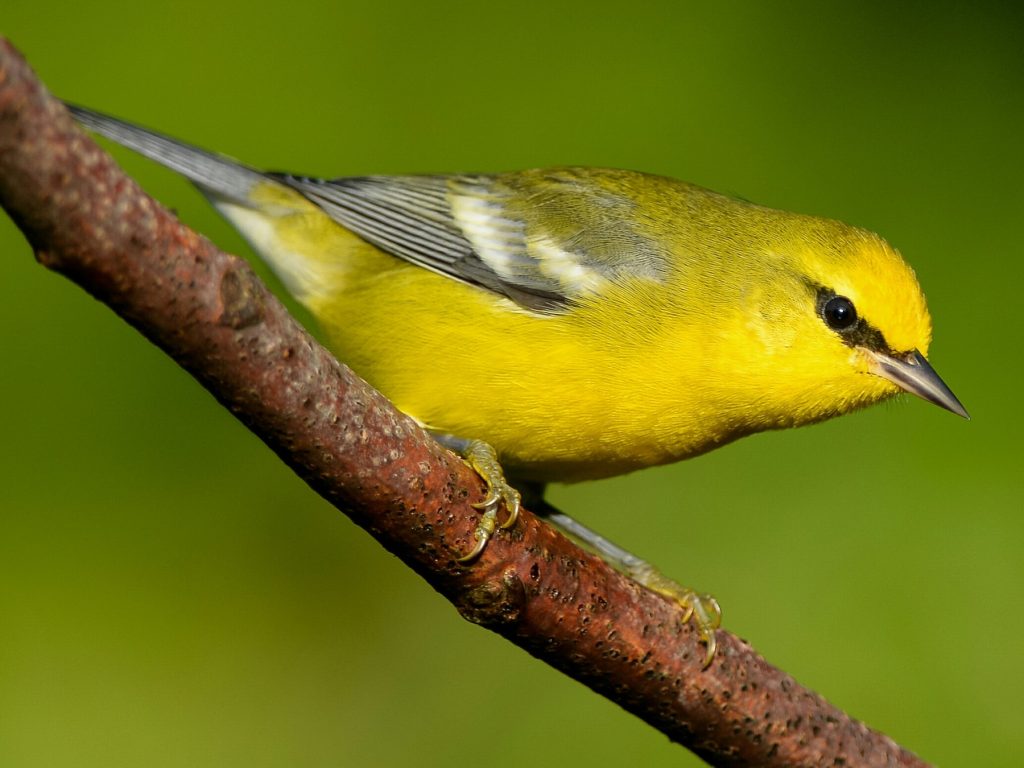
Blue-winged Warblers grace Massachusetts during the breeding season, typically from May to July. They are recorded in approximately 7% of summer checklists.
These small, lively birds feature bright yellow plumage, with males exhibiting distinct blue-gray wings and a yellow forehead. Females possess similar yellow coloration but lack the blue-gray wings.
Vermivora cyanoptera
Size: 4.3-5.1 in (11-13 cm)
Weight: 0.3-0.4 oz (9-12 g)
Wingspan: 7.1-7.9 in (18-20 cm)
Blue-winged Warblers breed in the northeastern and central regions of the United States before migrating to Mexico, Central America, and the Caribbean for winter.
They inhabit open habitats with shrubs and young forests, such as fields, clearings, and forest edges. Their diet mainly consists of insects, which they capture by gleaning and flycatching.
Blue-winged Warbler Song:
Their nests are typically located on the ground, hidden among grasses and vegetation. Constructed from grasses, leaves, and bark strips, the nests are lined with finer grasses and hair. Blue-winged Warblers lay around four to five eggs, which hatch after approximately ten to twelve days. The young birds leave the nest around eight to ten days after hatching.
To attract Blue-winged Warblers to your backyard, provide shrubby habitats with suitable nesting and foraging opportunities.
Interesting Fact: Blue-winged Warblers have a unique hybridization phenomenon with Golden-winged Warblers, resulting in hybrid offspring known as Brewster’s Warbler and Lawrence’s Warbler.
15. Yellow-throated Vireo

Yellow-throated Vireos visit Massachusetts during the breeding season, typically from May to August. They are observed in about 6% of summer checklists.
These medium-sized songbirds possess olive-green upperparts, with a distinct yellow throat and underparts. They have gray crowns and white spectacles around their eyes.
Vireo flavifrons
Size: 5.9-6.7 in (15-17 cm)
Weight: 0.5-0.6 oz (15-18 g)
Wingspan: 9.1-9.8 in (23-25 cm)
Yellow-throated Vireos breed in the eastern and central regions of the United States before migrating to Mexico and Central
America for winter.
They are commonly found in deciduous and mixed forests, often near water sources. Yellow-throated Vireos primarily feed on insects, including caterpillars, beetles, and spiders.
Yellow-throated Vireo Song:
Their nests are typically located in tall deciduous trees, suspended from a fork in the branches. Constructed from bark strips, grasses, and plant fibers, the nests are lined with finer materials such as feathers and hair. Yellow-throated Vireos lay around three to five eggs, which hatch after approximately twelve to thirteen days. The young birds leave the nest around twelve to fifteen days after hatching.
To attract Yellow-throated Vireos to your backyard, maintain a diverse and mature forested habitat with a variety of insect-rich trees.
Interesting Fact: Yellow-throated Vireos are known for their distinctive song, often described as a series of repeated phrases resembling the phrase “three-eight, here I am.”
16. White-eyed Vireo
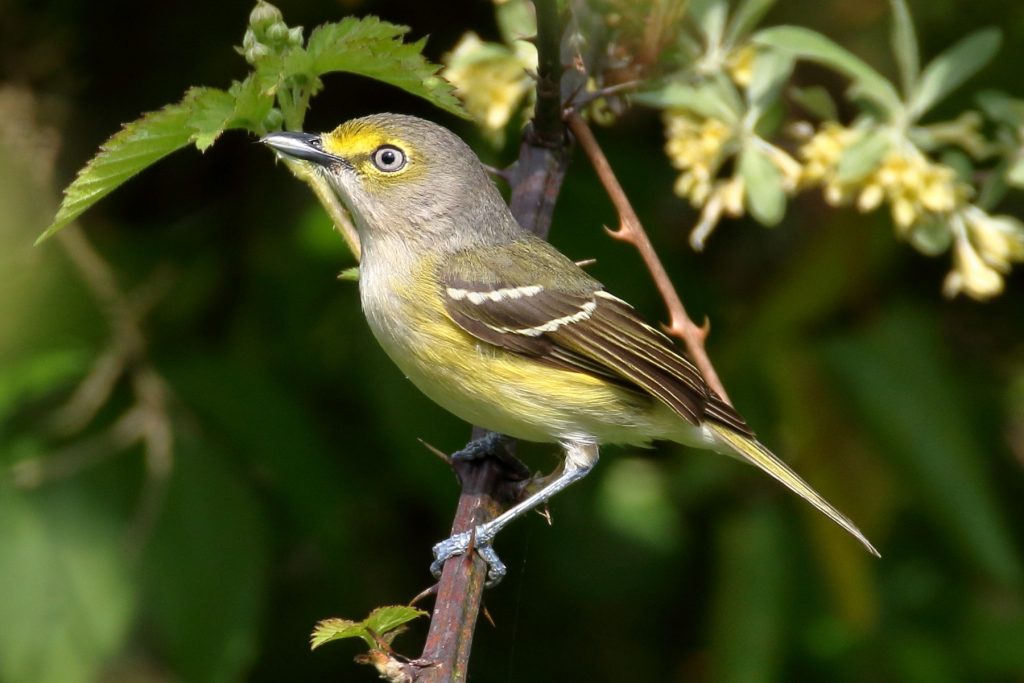
White-eyed Vireos grace Massachusetts during the breeding season, typically from May to August. They are recorded in approximately 5% of summer checklists.
These small, lively birds possess olive-green upperparts and yellow underparts, with a striking white eye ring. Males and females exhibit similar plumage.
Vireo griseus
Size: 4.7-5.5 in (12-14 cm)
Weight: 0.4-0.5 oz (11-14 g)
Wingspan: 7.5-8.3 in (19-21 cm)
White-eyed Vireos breed in the southeastern and central regions of the United States before migrating to Mexico, Central America, and the Caribbean for winter.
They prefer dense shrubby habitats, including thickets, brushy areas, and forest edges. White-eyed Vireos primarily feed on insects, spiders, and berries.
White-eyed Vireo Song:
Their nests are often located in shrubs or thickets, hidden within dense vegetation. Constructed from grasses, bark, plant fibers, and spider silk, the nests are lined with finer materials such as feathers and hair. White-eyed Vireos lay around three to four eggs, which hatch after approximately twelve days. The young birds leave the nest around nine to ten days after hatching.
To attract White-eyed Vireos to your backyard, provide dense shrubby habitats with a variety of insects and berry-producing plants.
Interesting Fact: White-eyed Vireos are known for their complex song, which consists of a series of varied phrases, often described as “quick, hurry up, quick.”
17. Hooded Warbler
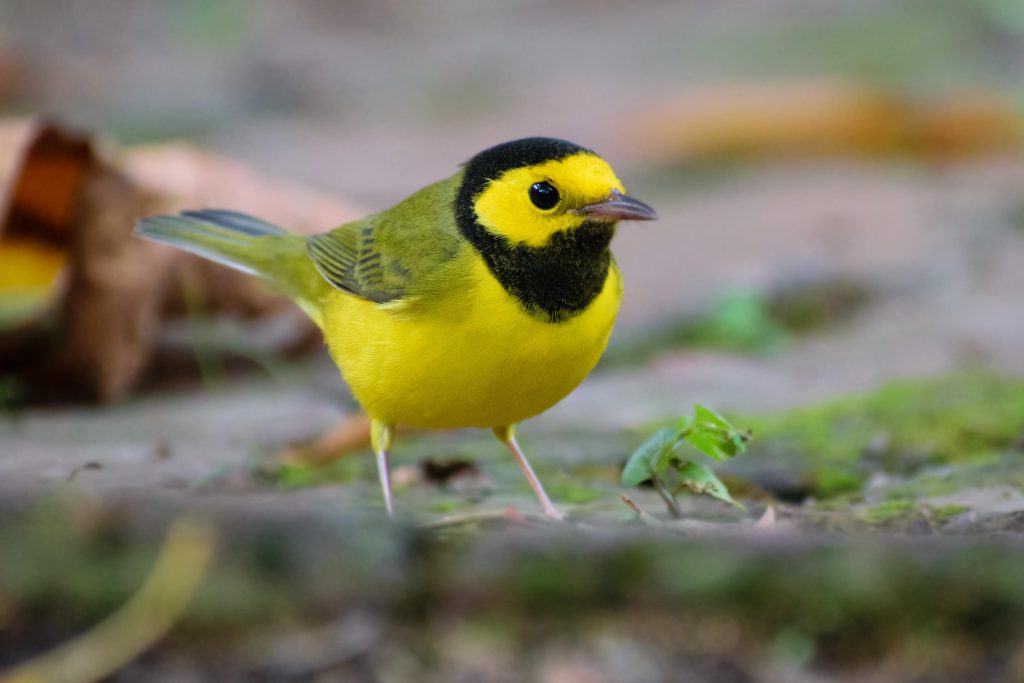
Hooded Warblers visit Massachusetturing the breeding season, typically from May to July. They are observed in about 4% of summer checklists.
These small, striking birds feature a bright yellow face and underparts, with a black hood extending from the head down to the breast. Females possess similar coloration but with a duller appearance.
Setophaga citrina
Size: 4.7-5.1 in (12-13 cm)
Weight: 0.3-0.4 oz (9-12 g)
Wingspan: 6.7-7.5 in (17-19 cm)
Hooded Warblers breed in the southeastern and central regions of the United States before migrating to Mexico and Central America for winter.
They are commonly found in understory habitats of deciduous forests, often near water sources. Hooded Warblers primarily feed on insects, including caterpillars, beetles, and spiders.
Hooded Warbler Song:
Their nests are typically located on or near the ground, hidden within leaf litter or dense vegetation.
Constructed from grasses, leaves, and other plant materials, the nests are lined with finer materials such as rootlets and hair. Hooded Warblers lay around three to four eggs, which hatch after approximately twelve to thirteen days. The young birds leave the nest around nine to ten days after hatching.
To attract Hooded Warblers to your backyard, provide dense understory vegetation and maintain a suitable insect population.
Interesting Fact: Hooded Warblers have a unique feeding behavior known as “leaf-turning,” where they use their bill to flip over leaves in search of hidden insects.
18. Prothonotary Warbler
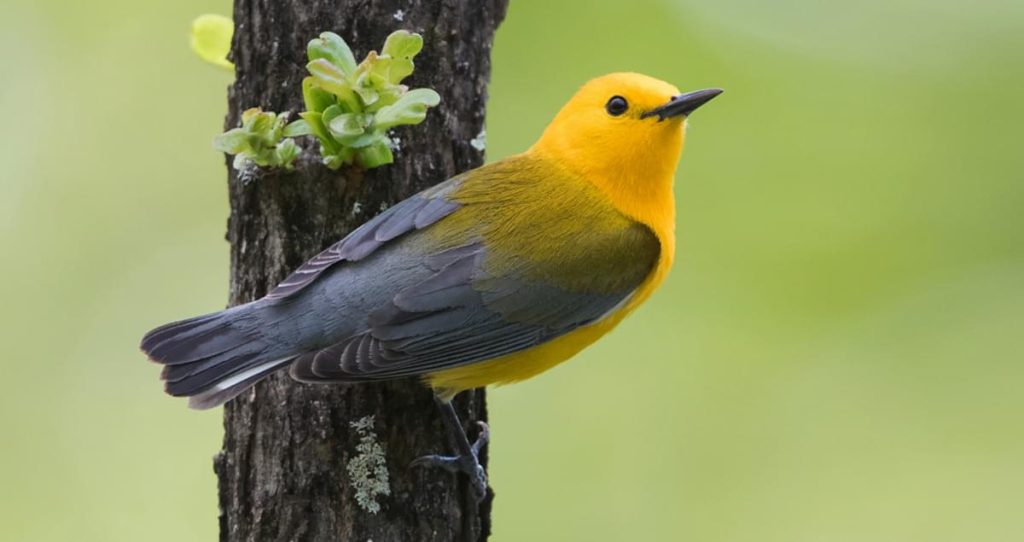
Prothonotary Warblers grace Massachusetts during the breeding season, typically from May to July. They are recorded in approximately 3% of summer checklists.
These small, vibrant birds possess bright yellow plumage, with bluish-gray wings and a distinctive orange-yellow crown. Males and females exhibit similar coloration.
Protonotaria citrea
Size: 4.3-5.1 in (11-13 cm)
Weight: 0.4-0.5 oz (11-14 g)
Wingspan: 7.1-7.9 in (18-20 cm)
Prothonotary Warblers breed in the southeastern and central regions of the United States before migrating to Mexico, Central America, and the Caribbean for winter.
They are commonly found in swampy habitats, including wetlands, marshes, and flooded forests. Prothonotary Warblers primarily feed on insects, spiders, and small crustaceans.
Prothonotary Warbler Song:
Their nests are often located in tree cavities or nest boxes near water sources. Constructed from grasses, leaves, and other plant materials, the nests are lined with finer materials such as feathers and hair. Prothonotary Warblers lay around four to seven eggs, which hatch after approximately twelve to fourteen days. The young birds leave the nest around ten to twelve days after hatching.
To attract Prothonotary Warblers to your backyard, provide nest boxes near water bodies and maintain suitable wetland habitats.
Interesting Fact: Prothonotary Warblers are the only eastern warbler species that nest in tree cavities instead of building open cup nests.
19. Evening Grosbeak
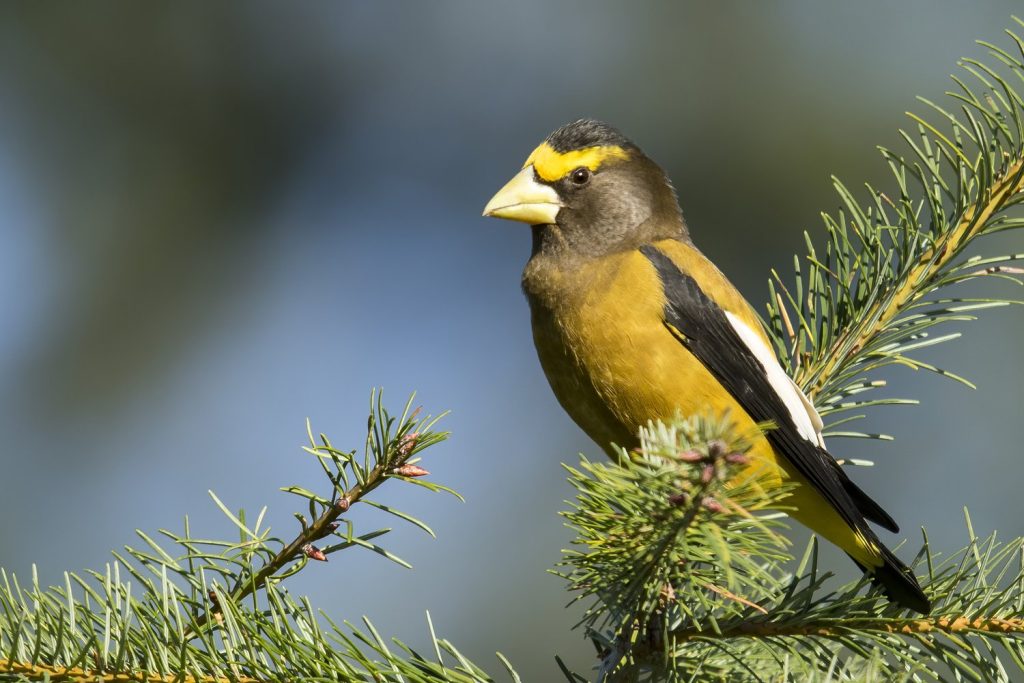
Evening Grosbeaks can be spotted in Massachusetts throughout the year, although they are more commonly seen in winter. They are recorded in up to 5% of winter checklists.
These robust birds feature a large beak, with males exhibiting a vibrant yellow body, black wings, and a distinct black forehead. Females possess similar coloration but with duller shades of yellow.
Coccothraustes vespertinus
Size: 7.5-8.7 in (19-22 cm)
Weight: 2.1-3.3 oz (60-93 g)
Wingspan: 12.2-13.8 in (31-35 cm)
Evening Grosbeaks are native to western North America but occasionally venture into the eastern regions, including Massachusetts. They are highly nomadic and can be found in a variety of habitats, including forests, woodlands, and residential areas.
Their diet consists of various seeds, buds, and fruits, including those from coniferous trees.
Evening Grosbeak Call:
Their nests are often located in trees, constructed from twigs, grasses, and rootlets, and lined with softer materials such as moss and hair. Evening Grosbeaks lay around three to five eggs, which hatch after approximately two weeks. The young birds leave the nest after about two weeks.
To attract Evening Grosbeaks to your backyard, provide a variety of seed feeders with sunflower seeds, as well
as trees and shrubs that produce fruits and seeds.
Interesting Fact: Evening Grosbeaks are known for their irregular irruptions, where large numbers of individuals move into new areas in search of food, often caused by changes in seed crops in their regular range.
20. Snow Bunting
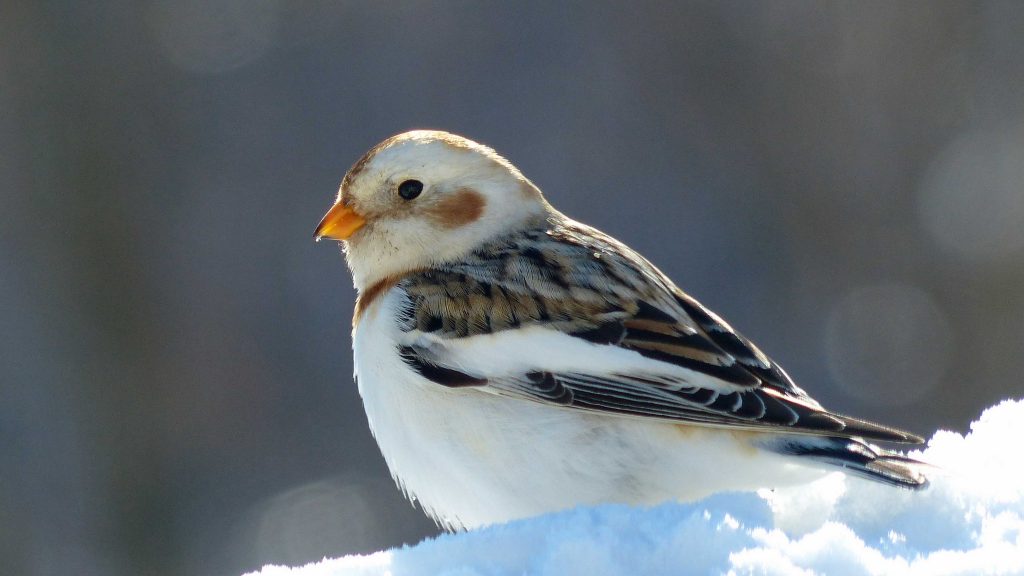
Snow Buntings can be observed in Massachusetts during the winter season, typically from November to March. They are recorded in up to 5% of winter checklists.
These small, compact birds showcase a striking appearance, with males exhibiting a mostly white plumage, black wings, and a rusty-brown back. Females possess similar coloration but with less contrasting patterns.
Plectrophenax nivalis
Size: 6.3-7.1 in (16-18 cm)
Weight: 1.2-2 oz (35-56 g)
Wingspan: 11.8-12.6 in (30-32 cm)
Snow Buntings breed in the high Arctic regions of North America before migrating south to wintering grounds. They are highly nomadic and can be found in a variety of open habitats, including fields, coastal areas, and tundra.
Their diet consists mainly of seeds, including those from grasses and weeds, supplemented with insects during the breeding season.
Snow Bunting Call:
Their nests are often located on the ground, hidden among vegetation or in rocky crevices. Constructed from grasses, leaves, and moss, the nests are lined with feathers and finer materials. Snow Buntings lay around four to six eggs, which hatch after approximately two weeks. The young birds leave the nest after about two weeks.
To attract Snow Buntings to your backyard, provide open areas with seed-bearing grasses and maintain a welcoming habitat during the winter season.
Interesting Fact: Snow Buntings undertake long-distance migrations, with some individuals traveling from the Arctic to the southern United States and even further south to Central America.
21. Orange-crowned Warbler

Orange-crowned Warblers pass through Massachusetts during migration, typically from April to May and September to October. They are observed in about 3% of checklists during these times.
These small, inconspicuous birds possess dull olive-green plumage, with a hint of yellow on their underparts. The orange crown patch is often hidden and not easily visible.
Leiothlypis celata
Size: 4.7-5.1 in (12-13 cm)
Weight: 0.3-0.4 oz (9-11 g)
Wingspan: 7.5-8.3 in (19-21 cm)
Orange-crowned Warblers breed in the western regions of North America, including Alaska and western Canada. They can be found during migration in various habitats, such as woodlands, shrubby areas, and gardens.
Their diet mainly consists of insects and spiders, which they forage for among foliage and branches.
Orange-crowned Warbler Song:
Their nests are cup-shaped and typically located low in shrubs or trees, constructed from grasses, plant fibers, and moss. Orange-crowned Warblers lay around four to six eggs, which hatch after approximately two weeks. The young birds leave the nest around ten to twelve days after hatching.
As Orange-crowned Warblers primarily pass through Massachusetts during migration, providing suitable habitat with dense vegetation and insect-attracting plants can help attract them.
Interesting Fact: Orange-crowned Warblers are known for their secretive nature and relatively subdued plumage, making them challenging to spot and identify in the field.
22. Yellow-throated Warbler

Yellow-throated Warblers pass through Massachusetts during migration, typically from April to May and September to October. They are observed in about 3% of checklists during these times.
These medium-sized songbirds possess bright yellow underparts, with a white throat and a black mask extending from the eyes to the upper chest. Their upperparts are olive-green.
Setophaga dominica
Size: 4.7-5.1 in (12-13 cm)
Weight: 0.3-0.4 oz (9-11 g)
Wingspan: 7.5-8.7 in (19-22 cm)
Yellow-throated Warblers breed in the southeastern regions of the United States before migrating to Mexico, Central America, and the Caribbean for winter.
They prefer swampy habitats, including bottomland forests, wetlands, and streamside areas. Yellow-throated Warblers primarily feed on insects, including caterpillars, beetles, and spiders.
Yellow-throated Warbler Song:
Their nests are cup-shaped and typically located in the fork of a tree branch, constructed from twigs, grasses, and plant fibers. Yellow-throated Warblers lay around three to five eggs, which hatch after approximately twelve days. The young birds leave the nest around nine to twelve days after hatching.
As Yellow-throated Warblers primarily pass through Massachusetts during migration, providing suitable habitat with ample insects and water sources can help attract them.
Interesting Fact: Yellow-throated Warblers are skilled at catching insects in flight, often performing acrobatic maneuvers to capture their prey.
23. Painted Bunting
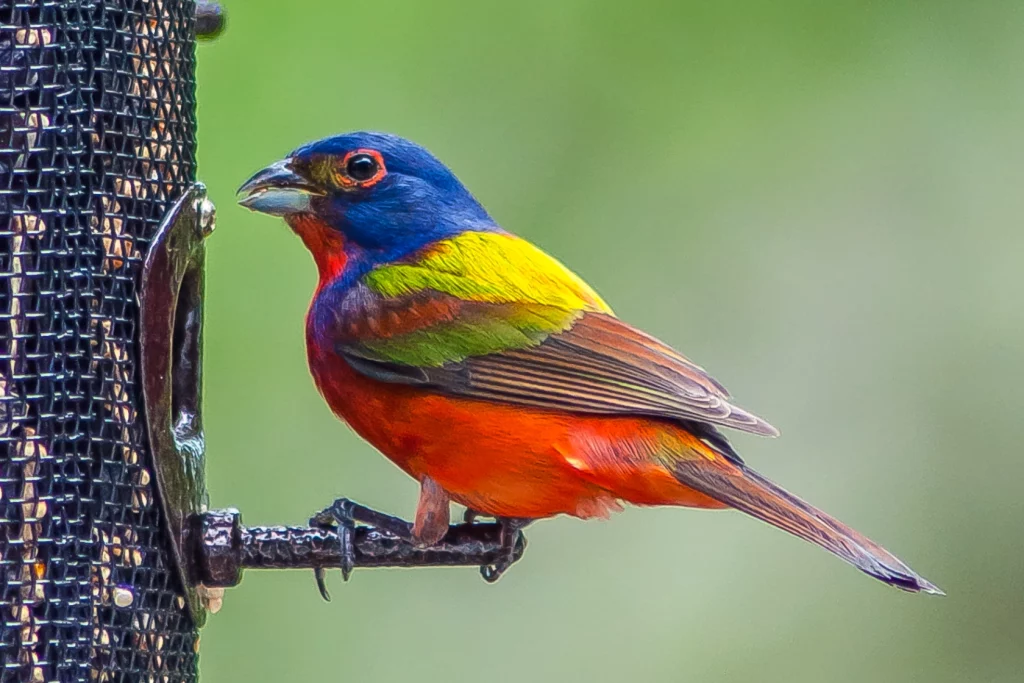
Painted Buntings can be spotted in Massachusetts during migration, typically from April to May and September to October. They are recorded in about 2% of checklists during these times.
These strikingly colorful birds showcase bright blue plumage on the head and back, with a vibrant red belly and underparts. Females possess more subdued greenish-yellow plumage.
Passerina ciris
Size: 4.7-5.5 in (12
-14 cm)
Weight: 0.5-0.7 oz (14-20 g)
Wingspan: 7.5-8.7 in (19-22 cm)
Painted Buntings breed in the southeastern regions of the United States before migrating to Mexico, Central America, and the Caribbean for winter.
They are commonly found in brushy habitats, including thickets, shrublands, and edges of woodlands. Painted Buntings primarily feed on seeds, fruits, and insects during the breeding season.
Painted Bunting Song:
Their nests are cup-shaped and typically located in dense vegetation, constructed from grasses, leaves, and other plant materials. Painted Buntings lay around three to four eggs, which hatch after approximately twelve days. The young birds leave the nest around ten to twelve days after hatching.
As Painted Buntings primarily pass through Massachusetts during migration, providing suitable habitat with dense vegetation and a variety of food sources can help attract them.
Interesting Fact: Male Painted Buntings are often referred to as the “most colorful bird in North America” due to their vibrant plumage, while females exhibit more camouflaged colors for better nesting protection.
24. Ruby-crowned Kinglet
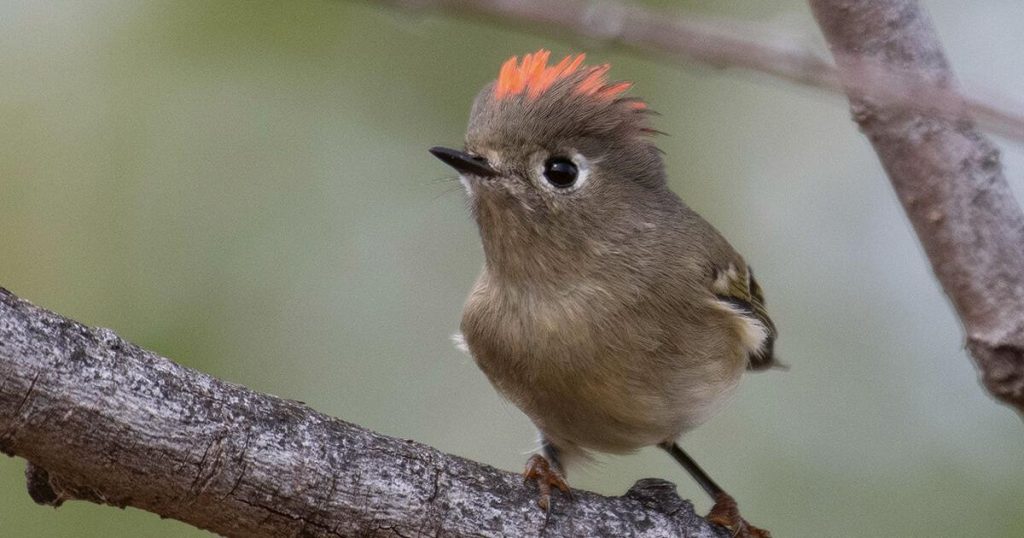
Ruby-crowned Kinglets pass through Massachusetts during migration, typically from April to May and September to October. They are observed in about 12% of checklists during these times.
These small, energetic birds possess olive-green upperparts, with a bright white eye-ring. Males exhibit a hidden ruby-red crown patch that is usually concealed but can be revealed during courtship or when excited.
Regulus calendula
Size: 3.5-4.3 in (9-11 cm)
Weight: 0.2-0.3 oz (5-8 g)
Wingspan: 5.9-6.7 in (15-17 cm)
Ruby-crowned Kinglets breed in the northern regions of North America, including Alaska and Canada. They can be found during migration in various habitats, such as woodlands, forests, and shrubby areas.
Their diet primarily consists of insects and spiders, which they forage for among foliage and branches.
Ruby-crowned Kinglet Song:
Their nests are cup-shaped and typically located high in coniferous trees, constructed from moss, lichens, and plant fibers, and lined with feathers and fine materials. Ruby-crowned Kinglets lay around five to eleven eggs, which hatch after approximately two weeks. The young birds leave the nest around two weeks after hatching.
As Ruby-crowned Kinglets primarily pass through Massachusetts during migration, providing suitable habitat with dense vegetation and insect-attracting plants can help attract them.
Interesting Fact: The ruby-red crown patch of male Ruby-crowned Kinglets is often hidden, and its display is considered a territorial or courtship behavior.
25. Nashville Warbler
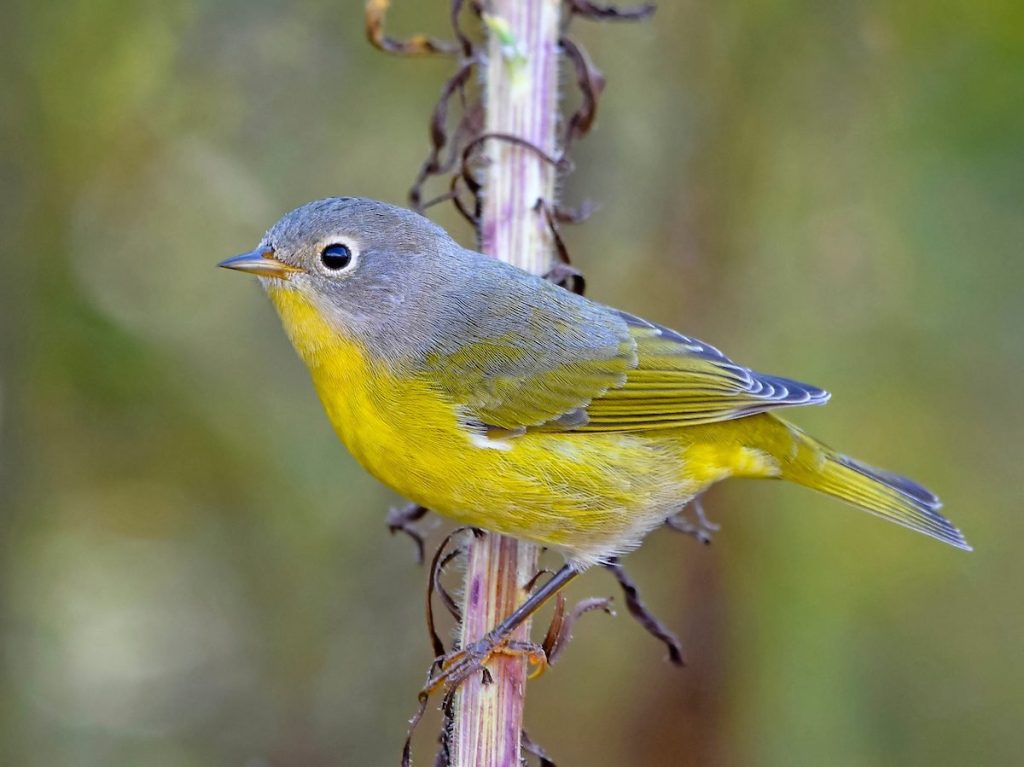
Nashville Warblers pass through Massachusetts during migration, typically from April to May and September to October. They are observed in about 8% of checklists during these times.
These small, active birds possess bright yellow underparts, with an olive-green back and a distinctive gray head. A prominent white eye-ring adds to their appearance.
Leiothlypis ruficapilla
Size: 4.3-4.7 in (11-12 cm)
Weight: 0.3-0.4 oz (8-11 g)
Wingspan: 6.3-7.1 in (16-18 cm)
Nashville Warblers breed in the northern regions of North America, including Canada and Alaska. They can be found during migration in various habitats, such as woodlands, forests, and shrubby areas.
Their diet consists mainly of insects and spiders,
which they forage for among foliage and branches.
Nashville Warbler Song:
Their nests are cup-shaped and typically located low in shrubs or trees, constructed from grasses, plant fibers, and bark strips. Nashville Warblers lay around three to six eggs, which hatch after approximately twelve to thirteen days. The young birds leave the nest around nine to ten days after hatching.
As Nashville Warblers primarily pass through Massachusetts during migration, providing suitable habitat with ample insects and water sources can help attract them.
Interesting Fact: Nashville Warblers were named after Nashville, Tennessee, where they were first discovered by naturalist Alexander Wilson in 1811.
26. Wilson’s Warbler
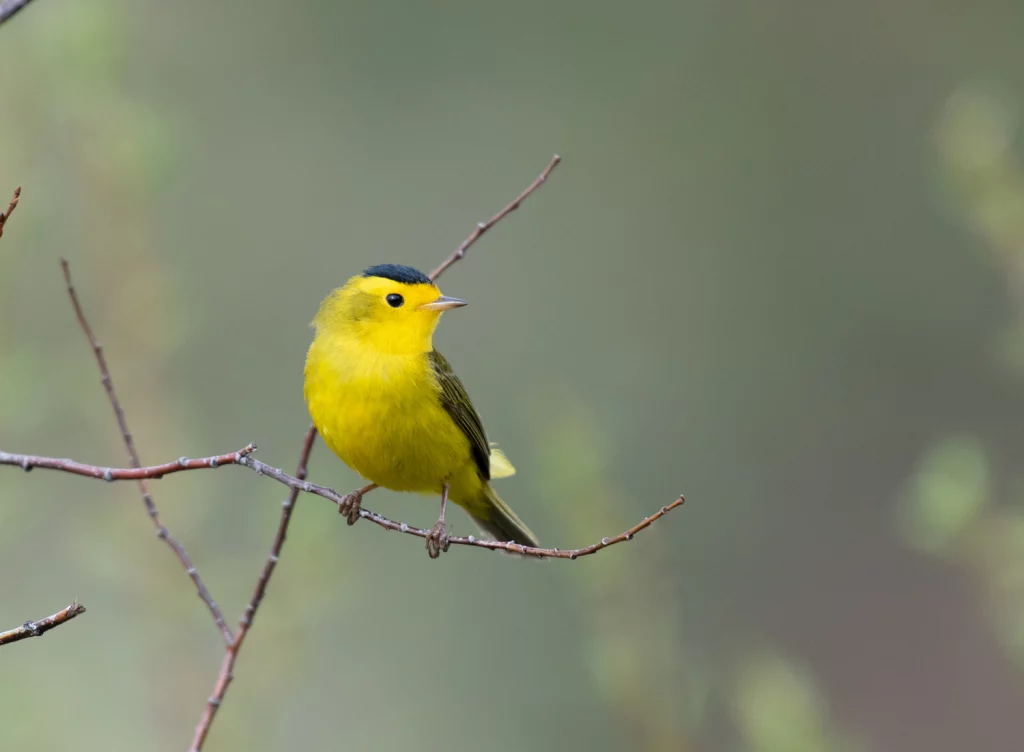
Wilson’s Warblers pass through Massachusetts during migration, typically from April to May and September to October. They are observed in about 7% of checklists during these times.
These small, energetic birds possess bright yellow underparts, with an olive-green back and a distinct black cap. Males and females exhibit similar coloration.
Cardellina pusilla
Size: 4.3-4.7 in (11-12 cm)
Weight: 0.3-0.4 oz (8-11 g)
Wingspan: 6.3-7.1 in (16-18 cm)
Wilson’s Warblers breed in the western regions of North America, including Alaska and Canada. They can be found during migration in various habitats, such as woodlands, forests, and shrubby areas.
Their diet mainly consists of insects and spiders, which they forage for among foliage and branches.
Wilson’s Warbler Song:
Their nests are cup-shaped and typically located low in shrubs or trees, constructed from grasses, plant fibers, and moss. Wilson’s Warblers lay around four to six eggs, which hatch after approximately twelve days. The young birds leave the nest around nine to ten days after hatching.
As Wilson’s Warblers primarily pass through Massachusetts during migration, providing suitable habitat with ample insects and water sources can help attract them.
Interesting Fact: Wilson’s Warblers have one of the fastest song rates among North American warblers, producing up to 12 songs per second.
27. Canada Warbler
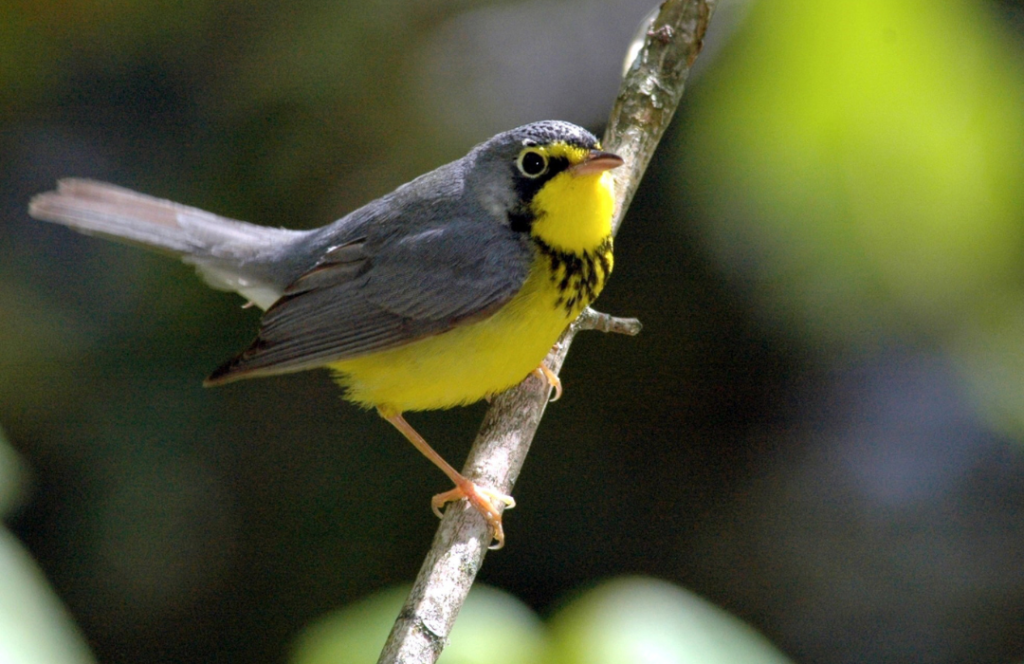
Canada Warblers pass through Massachusetts during migration, typically from May to June and August to September. They are observed in about 5% of checklists during these times.
These medium-sized songbirds possess a gray back, with a bright yellow underparts and a distinctive necklace-like pattern of black streaks on their chest. Males and females exhibit similar coloration.
Cardellina canadensis
Size: 4.7-5.1 in (12-13 cm)
Weight: 0.3-0.4 oz (9-11 g)
Wingspan: 7.1-7.9 in (18-20 cm)
Canada Warblers breed in the northeastern regions of North America, including Canada and the northern United States. They can be found during migration in various habitats, such as forests, woodlands, and wet areas.
Their diet primarily consists of insects, including caterpillars, beetles, and spiders.
Canada Warbler Song:
Their nests are cup-shaped and typically located on the ground or in low vegetation, constructed from grasses, plant fibers, and moss. Canada Warblers lay around four to five eggs, which hatch after approximately twelve to thirteen days. The young birds leave the nest around nine to ten days after hatching.
As Canada Warblers primarily pass through Massachusetts during migration, providing suitable habitat with ample insects and dense vegetation can help attract them.
Interesting Fact: Canada Warblers are known for their unique breeding behavior, often parasitizing nests of other bird species, such as Yellow Warblers or Magnolia Warblers, by laying
their eggs in those nests.
28. Cape May Warbler
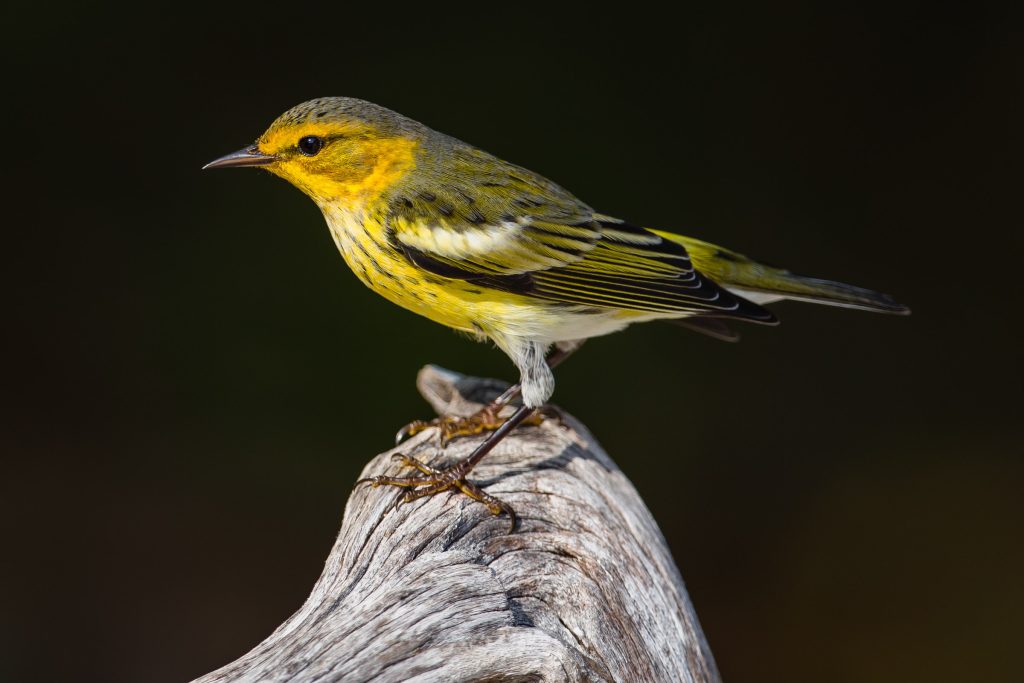
Cape May Warblers pass through Massachusetts during migration, typically from May to June and August to September. They are observed in about 4% of checklists during these times.
These small, active birds possess bright yellow underparts, with an olive-green back and a distinct chestnut cheek patch. Males and females exhibit similar coloration, but females may appear duller.
Setophaga tigrina
Size: 4.7-5.1 in (12-13 cm)
Weight: 0.3-0.4 oz (9-11 g)
Wingspan: 7.1-7.9 in (18-20 cm)
Cape May Warblers breed in the boreal forests of North America, including Canada and Alaska. They can be found during migration in various habitats, such as woodlands, forests, and shrubby areas.
Their diet mainly consists of insects, including caterpillars, spiders, and nectar from flowers.
Cape May Warbler Song:
Their nests are cup-shaped and typically located in coniferous trees, constructed from twigs, grasses, plant fibers, and lined with fine materials. Cape May Warblers lay around four to five eggs, which hatch after approximately twelve to thirteen days. The young birds leave the nest around nine to ten days after hatching.
As Cape May Warblers primarily pass through Massachusetts during migration, providing suitable habitat with ample insects and nectar-producing flowers can help attract them.
Interesting Fact: The Cape May Warbler’s unique feeding behavior involves extracting nectar from flowers by piercing the base of the flower with its beak and using its specialized tongue to lap up the nectar.
29. Dickcissel
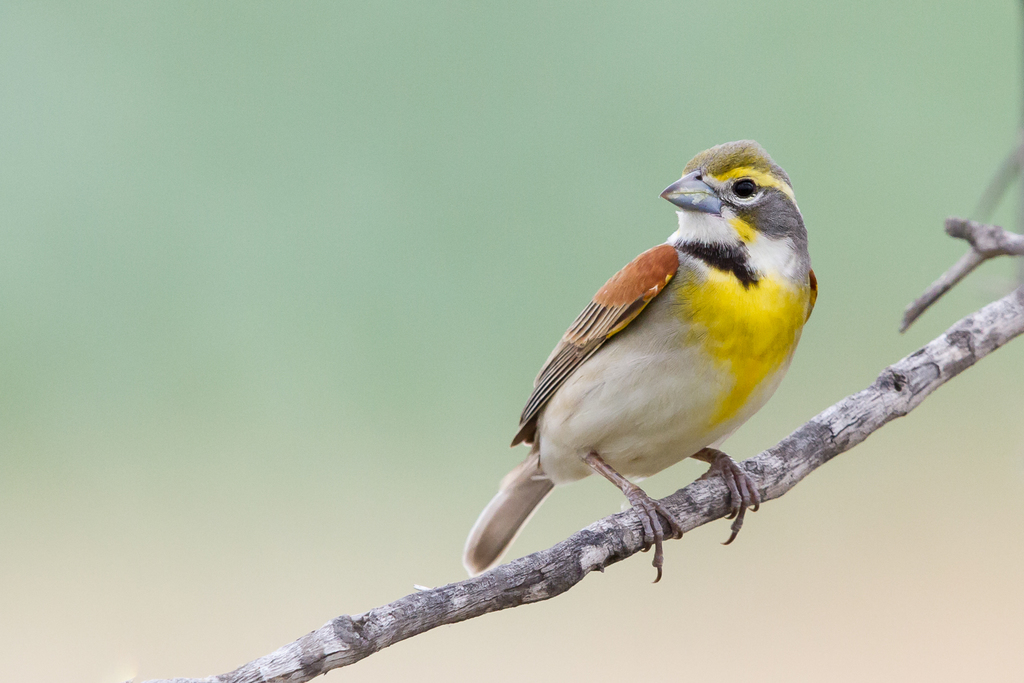
Dickcissels pass through Massachusetts during migration, typically from May to June and August to September. They are observed in about 3% of checklists during these times.
These medium-sized songbirds possess a combination of yellow and brown plumage, with a distinctive black V-shaped pattern on their chest. Males and females exhibit similar coloration.
Spiza americana
Size: 5.9-6.7 in (15-17 cm)
Weight: 1.1-1.3 oz (30-37 g)
Wingspan: 9.8-10.6 in (25-27 cm)
Dickcissels breed in the central regions of North America, including the Great Plains and Midwest. They can be found during migration in various habitats, such as grasslands, agricultural fields, and prairies.
Their diet primarily consists of seeds, including those from grasses, weeds, and agricultural crops.
Dickcissel Song:
Their nests are cup-shaped and typically located on the ground or in low vegetation, constructed from grasses, plant fibers, and stems. Dickcissels lay around three to five eggs, which hatch after approximately eleven to twelve days. The young birds leave the nest around nine to ten days after hatching.
As Dickcissels primarily pass through Massachusetts during migration, providing suitable habitat with open fields and abundant seed sources can help attract them.
Interesting Fact: Dickcissels are known for their distinctive song, which resembles the sound “dick-dick-ciss-ciss-ciss,” giving them their name.
30. Western Kingbird

Western Kingbirds pass through Massachusetts during migration, typically from May to June and August to September. They are observed in about 2% of checklists during these times.
These medium-sized songbirds possess a combination of yellow and gray plumage, with a pale belly and a prominent white outer tail feather. They have a distinct white-edged black tail band.
Tyrannus verticalis
Size:
7.1-8.3 in (18-21 cm)
Weight: 1.2-1.4 oz (34-39 g)
Wingspan: 12.6-14.2 in (32-36 cm)
Western Kingbirds breed in the western regions of North America, including parts of Canada and the United States. They can be found during migration in various habitats, such as open woodlands, shrubby areas, and along water bodies.
Their diet consists mainly of insects, including bees, wasps, grasshoppers, and flying insects.
Western Kingbird Call:
They construct cup-shaped nests made of twigs, grasses, and plant fibers, which are usually located on horizontal branches or in the forks of trees. Western Kingbirds lay around three to six eggs, which hatch after approximately thirteen to fourteen days. The young birds leave the nest around eighteen to twenty-one days after hatching.
As Western Kingbirds primarily pass through Massachusetts during migration, providing suitable habitat with open spaces and perches for hunting can help attract them.
Interesting Fact: Western Kingbirds are known for their aggressive behavior when defending their territory, often engaging in aerial pursuits and dive-bombing intruders.
31. Lark Sparrow
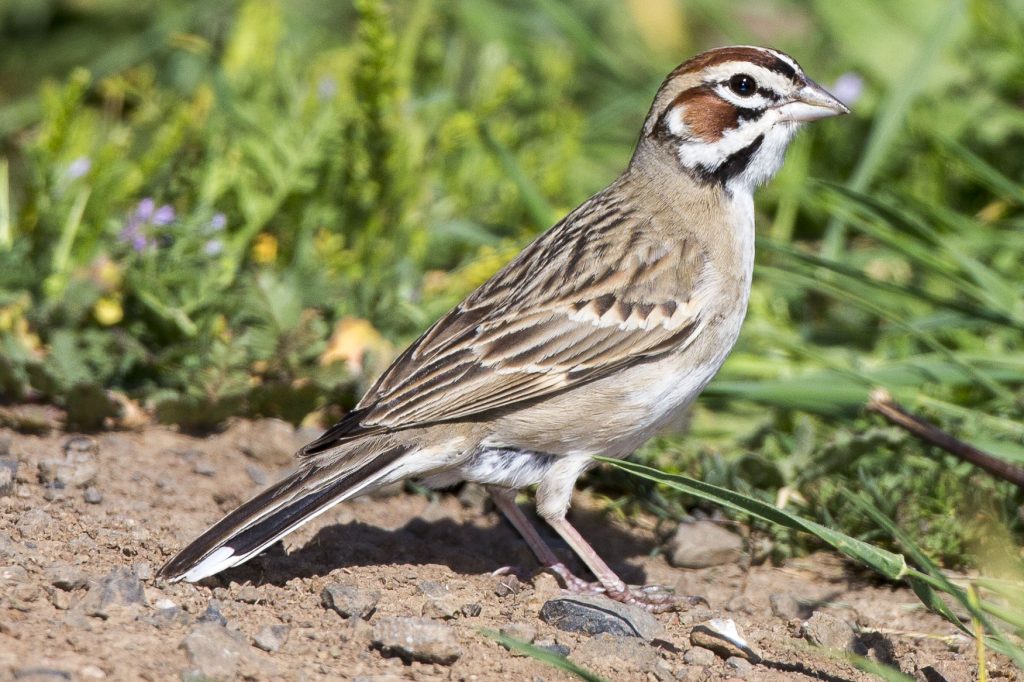
Lark Sparrows pass through Massachusetts during migration, typically from May to June and August to September. They are observed in about 2% of checklists during these times.
These medium-sized sparrows possess a unique combination of colors, with a gray head, a bold black facial pattern, and a reddish-brown and white striped back. They have a distinct white tail with black central feathers.
Chondestes grammacus
Size: 6.3-7.1 in (16-18 cm)
Weight: 1.1-1.3 oz (31-37 g)
Wingspan: 9.1-9.8 in (23-25 cm)
Lark Sparrows breed in the central and western regions of North America, including parts of Canada and the United States. They can be found during migration in various habitats, such as grasslands, open fields, and prairies.
Their diet consists mainly of seeds, including those from grasses, weeds, and agricultural crops, but they also consume insects during the breeding season.
Lark Sparrow Call:
They construct cup-shaped nests made of grasses, plant stems, and rootlets, which are usually located on the ground or low vegetation. Lark Sparrows lay around three to five eggs, which hatch after approximately twelve to fourteen days. The young birds leave the nest around nine to ten days after hatching.
As Lark Sparrows primarily pass through Massachusetts during migration, providing suitable habitat with open areas and ample seed sources can help attract them.
Interesting Fact: Lark Sparrows are known for their melodic and complex song, which includes a variety of trills, buzzes, and notes.
32. Golden-winged Warbler
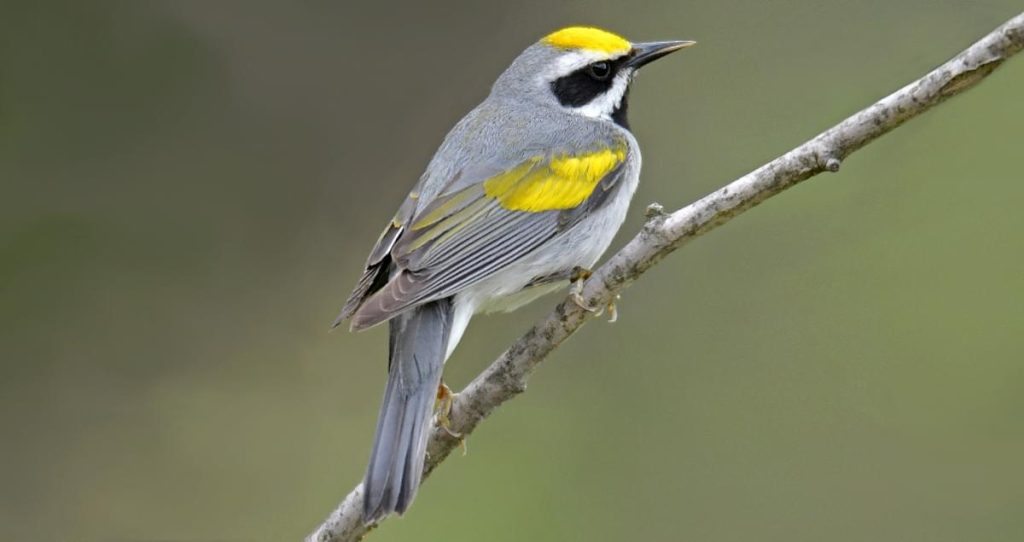
Golden-winged Warblers pass through Massachusetts during migration, typically from May to June and August to September. They are observed in about 1% of checklists during these times.
These small, vibrant birds possess bright yellow plumage on their underparts, with a gray back and a distinctive golden wing patch. Males and females exhibit similar coloration, but females may appear duller.
Vermivora chrysoptera
Size: 4.7-5.1 in (12-13 cm)
Weight: 0.3-0.4 oz (8-11 g)
Wingspan: 7.1-7.9 in (18-20 cm)
Golden-winged Warblers breed in the northeastern regions of North America, including parts of Canada and the United States.They can be found during migration in various habitats, such as shrubby areas, forest edges, and wetlands.
Their diet primarily consists of insects, including caterpillars, beetles, and flies.
Golden-winged Warbler Song:
They construct cup-shaped nests made of grasses, plant fibers, and bark strips, which are usually located on the ground or low vegetation. Golden-winged Warblers lay around four to six eggs, which hatch after approximately twelve to thirteen days. The young birds leave the nest around nine to ten days after hatching.
As Golden-winged Warblers primarily pass through Massachusetts during migration, providing suitable habitat with dense shrubs, forest edges, and insect-rich environments can help attract them.
Interesting Fact: Golden-winged Warblers are known for their distinctive wing patches, which provide them with their name and aid in species identification. However, this species faces conservation concerns due to habitat loss and hybridization with Blue-winged Warblers.
